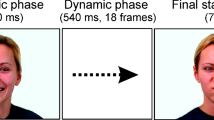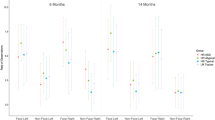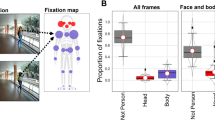Abstract
It has been established that typically developing individuals have a bias to attend to facial information in the left visual field (LVF) more than in the right visual field. This bias is thought to arise from the right hemisphere’s advantage for processing facial information, with evidence suggesting it to be driven by the configural demands of face processing. Considering research showing that individuals with autism have impaired face processing abilities, with marked deficits in configural processing, it was hypothesized that they would not demonstrate a LVF bias for faces. Eye-tracking technology was used to show that individuals with autism were not spontaneously biased to facial information in the LVF, in contrast to a control group, while discriminating facial gender.




Similar content being viewed by others
References
American Psychiatric Association. (2000). Diagnostic and statistical manual of mental disorders (4th ed.). Washington, DC: American Psychiatric Association.
Ashwin, C., Wheelwright, S., & Baron-Cohen, S. (2005). Laterality biases to chimeric faces in asperger syndrome: What is ‘right’ about face-processing? Journal of Autism and Developmental Disorders, 35(2), 183–196.
Aylward, E. H., Park, J. E., Field, K. M., Parson, A. C., Richards, T. L., Cramer, S. C., et al. (2005). Brain activation during face perception: Evidence of a developmental change. Journal of Cognitive Neuroscience, 17, 308–319.
Best, C. A., Minshew, N. J., & Strauss, M. S. (2010). Gender discrimination of eyes and mouth by individuals with autism. Autism Research, 3(2), 88–93.
Boucher, J., & Lewis, V. (1992). Unfamiliar face recognition in relatively able autistic children. Journal of Child Psychology and Psychiatry, 33, 843–859.
Boucher, J., Lewis, V., & Collis, G. (1998). Familiar face and voice matching and recognition in children with autism. Journal of Child Psychology and Psychiatry, 39, 171–181.
Burt, D. M., & Perrett, D. I. (1997). Perceptual asymmetries in judgements of facial attractiveness, age, gender, speech and expression. Neuropsychologia, 35, 685–693.
Butler, S., Gilchrist, I. D., Burt, D. M., Perrett, D. I., Jones, E., & Harvey, M. (2005). Are the perceptual biases found in chimeric face processing reflected in eye-movement patterns? Neuropsychologia, 43, 52–59.
Butler, S. H., & Harvey, M. (2006). Perceptual biases in chimeric face processing: Eye-movement patterns cannot explain it all. Brain research, 1124(1), 96–99.
Coolican, J., Eskes, G. A., McMullen, P. A., & Lecky, E. (2008). Perceptual biases in processing facial identity and emotion. Brain and Cognition, 66, 176–187.
Corden, B., Chilvers, R., & Skuse, D. (2006). Emotional modulation of perception in asperger’s syndrome. Journal of Autism and Developmental Disorders, 38(6), 1072–1080.
Curby, K., Willenbockel, V., Tanaka, J., & Schultz, R. (2010). Face processing in autism: Insights from the perceptual expertise framework. In I. Gauthier, M. Tarr, & D. Bub (Eds.), Perceptual expertise: Bridging brain, behavior. New York: Oxford University Press.
Davies, S., Bishop, D., Manstead, A. S. R., & Tantam, D. (1994). Face perception in children with autism and Asperger’s syndrome. Journal of Child Psychology and Psychiatry, 35, 1033–1057.
De Renzi, E. (1986). Current issues on prosopagnosia. In H. D. Ellis, M. A. Jeeves, F. Newcombe, & A. Young (Eds.), Aspects of face processing (pp 234–252). Netherlands: Martinus Nijhoff.
De Renzi, E., Perani, D., Carlesimo, G. A., Silveri, M. C., & Fazio, F. (1994). Prosopagnosia can be associated with damage confined to the right hemisphere–an MRI and PET study and a review of the literature. Neuropsychologia, 32, 893–902.
Diamond, R., & Carey, S. (1986). Why faces are and are not special: An effect of expertise. Journal of Experimental Psychology: General, 115, 107–117.
Fletcher-Watson, S., Leekam, S. R., Benson, V., Frank, M. C., & Findlay, J. M. (2009). Eye movements reveal attention to social information in autism spectrum disorder. Neuropsychologia, 47, 248–257.
Gajewski, P. D., Schlegel, K., & Stoerig, P. (2008). Effects of human race and face inversion on the N170: A cross-race study. Federation of European Psychophysiological Societies, 22, 157–165.
Gauthier, I., & Tarr, M. J. (1996). Becoming a “greeble” expert: Exploring mechanisms for face recognition. Vision Research, 37, 1673–1682.
Gauthier, I., Williams, P., Tarr, M. J., & Tanaka, J. (1998). Training ‘greeble’ experts: A framework for studying expert object recognition processes. Vision Research, 38, 2401–2428.
Gilbert, C., & Bakan, P. (1973). Visual asymmetry in the perception of faces. Neuropsychologia, 11, 355–362.
Guo, K., Meints, K., Hall, C., Hall, S., & Mills, D. (2009). Left gaze bias in humans, rhesus monkeys and domestic dogs. Animal Cognition, 12, 409–418.
Hannigen, S., Best, C., Rump, K., Minshew, N. J., & Strauss, M. S. (2009). An eye-tracking study: The effect of task on visual attention faces in autism. Chicago, Il: International Meetings for Autism Research.
Haxby, J. V., Hoffman, E. A., & Gobbini, M. I. (2000). The distributed human neural system for face perception. Trends in Cognitive Sciences, 4, 223–233.
Hernandez, N., Metzger, A., Magné, R., Bonnet-Brilhault, F., Roux, S., Barthelemy, C., et al. (2009). Exploration of core features of a human face by healthy and autistic adults analyzed by visual scanning. Neuropsychologia, 47, 1004–1012.
Hsiao, J. H., & Cottrell, G. W. (2009). Not all visual expertise is holistic, but it may be leftist. Psychological Science, 20(4), 455–463.
Klin, A., Sparrow, S. S., de Bildt, A., Cicchetti, D. V., Cohen, D. J., & Volkmar, F. R. (1999). A normed study of face recognition in autism and related disorders. Journal of Autism and Developmental Disorders, 29(6), 499–508.
Klin, A., Jones, W., Schultz, R., Volkmar, F., & Cohen, D. (2002). Visual fixation patterns during viewing of naturalistic social situations as predictors of social competence in individuals with autism. Archives of General Psychiatry, 59, 809–816.
Leehey, S. C., Carey, S., Diamond, R., & Cahn, A. (1978). Upright and inverted faces: The right hemisphere knows the difference. Cortex, 14, 411–419.
Levine, S. C., Banich, M. T., & Koch-Weser, M. P. (1988). Face recognition: A general or specific right hemisphere capacity? Brain and Cognition, 8, 303–325.
Lord, C., Rutter, M., DiLavore, P. C., & Risi, S. (2003). Autism diagnostic observation schedule (ADOS). Los Angeles, CA: Western Psychological Services.
Luh, K. E. (1998). Effect of inversion on perceptual biases for chimeric faces. Brain and Cognition, 37(1), 105–108.
Luh, K. E., Rueckert, L. M., & Levy, J. (1991). Perceptual asymmetries for free viewing of several types of chimeric stimuli. Brian and Cognition, 16(1), 83–103.
Maurer, D., Le Grand, R., & Mondloch, C. J. (2002). The many faces of configural processing. Trends in Cognitive Sciences, 6(6), 255–260.
Neumann, D., Spezio, M. L., Piven, J., & Adolphs, R. (2006). Looking you in the mouth: Abnormal gaze in autism resulting from impaired top-down modulation of visual attention. Social Cognitive and Affective Neuroscience, 1, 194–202.
Newell, L. C., Best, C. A., Gastgeb, H., Rump, K. A., & Strauss, M. S. (2010). The development of categorization and facial knowledge: Implications for the study of autism. In L. M. Oakes, C. H. Cashon, M. Casasola, & D. H. Rakison (Eds.), The information-processing infant. New York: Oxford University Press.
Norbury, C. F., Brock, J., Cragg, L., Einav, S., Griffiths, H., & Nelson, K. (2009). Eye-movement patterns are associated with communicative competence in autistic spectrum disorders. Journal of Child Psychology and Psychiatry, 50, 834–842.
Pelphrey, K. A., Sasson, N. J., Reznick, J. S., Paul, G., Goldman, B. D., & Piven, J. (2002). Visual scanning of faces in autism. Journal of Autism and Developmental Disorders, 32, 249–261.
Rhodes, G. (1993). Configural coding, expertise, and the right hemisphere advantage for face recognition. Brain and Cognition, 22, 19–41.
Rutter, M., LeCouteur, A., & Lord, C. (2003). Autism diagnostic interview-revised (ADI-R). Los Angeles, CA: Western Psychological Services.
Sasson, N. J. (2006). The development of face processing in autism. Journal of Autism and Developmental Disorders, 36, 381–394.
van der Geest, J. N., Kemner, C., Camfferman, G., Verbaten, M. N., & van Engeland, H. (2002). Looking at images with human figures: Comparison between autism and normal children. Journal of Autism and Developmental Disorders, 32(2), 69–75.
Wang, A. T., Dapretto, M., Hariri, A. R., Signman, M., & Bookheimer, S. Y. (2003). Neural correlates of facial affect processing in children and adolescents with autism spectrum disorder. Journal of the American Academy of Child and Adolescent Psychiatry, 43(4), 481–490.
Wechsler, D. (1999). Wechsler abbreviated intelligence scale. San Antonio, TX: The Psychological Corporation.
Wilkinson, G., & Robertson, G. (2006). Wide range achievement test 4 professional manual. Lutz, FL: Psychological Assessment Resources.
Wolff, W. (1933). The experimental study of forms of expression. Character & Personality, 2, 168–176.
Yovel, G., & Kanwisher, N. (2005). The neural basis of the behavioral face-inversion effect. Current Biology, 15, 2256–2262.
Yovel, G., Tambini, A., & Brandman, T. (2008). The asymmetry of the fusiform face area is a stable individual characteristic that underlies the left-visual-field superiority for faces. Neuropsychologia, 46, 3061–3068.
Acknowledgments
This research was supported by grant from the National Institutes of Health. The authors would like to thank Dr. Charles Nelson, Dr. Giulia Righi and Dr. Marlene Behrmann for their helpful comments and discussion of the project. We also thank Kao-Wei Chua for his help in formatting the paper, and Dr. Holly Gastgeb, Dr. Keiran Rump, Desiree Wilkinson, Sarah Hannigen, Sara Green and Kao-Wei Chua for testing participants.
Author information
Authors and Affiliations
Corresponding author
Rights and permissions
About this article
Cite this article
Dundas, E.M., Best, C.A., Minshew, N.J. et al. A Lack of Left Visual Field Bias When Individuals with Autism Process Faces. J Autism Dev Disord 42, 1104–1111 (2012). https://doi.org/10.1007/s10803-011-1354-2
Published:
Issue Date:
DOI: https://doi.org/10.1007/s10803-011-1354-2




